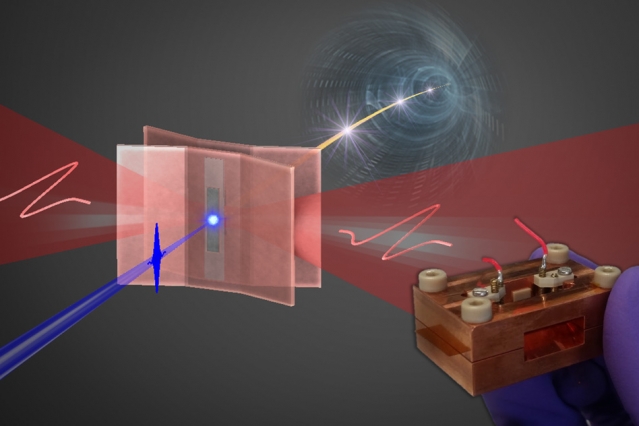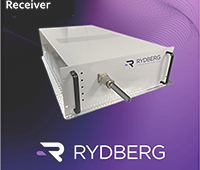
This illustration shows a miniature electron gun driven by terahertz radiation. A UV pulse (blue) back-illuminates the gun photocathode, producing a high-density electron bunch inside the gun. The bunch is immediately accelerated by ultra-intense terahertz pulses to energies approaching 1 kiloelectronvolt. These high-field optically-driven electron guns can be utilized for ultrafast electron diffraction or injected into the accelerators for X-ray light sources. (Credit: W. Ronny Huang)
A new technique for generating electron bursts could pave the way for advancements in producing X-ray movies.
Researchers at the Massachusetts Institute of Technology, the German Synchrotron and the University of Hamburg in Germany, have developed a new technique using ultrashort electron beams that after being fired down a particle accelerator a half a mile long, could be used to produce ultrashort X-rays.
“We’re building a tool for the chemists, physicists and biologists who use X-ray light sources or the electron beams directly to do their research,” Ronny Huang, an MIT Ph.D. student in electrical engineering and first author on the new paper, said in a statement.
“Because these electron beams are so short, they allow you to kind of freeze the motion of electrons inside molecules as the molecules are undergoing a chemical reaction. A femtosecond X-ray light source requires more hardware, but it utilizes electron guns.”
The research could be the basis of a shoebox-sized device that consumes only a faction as much power as its predecessors.
The same team of researchers reported last year the prototype of a small “linear accelerator” that could serve the same purpose as the much larger and more expensive particle accelerator. This technique could shrink particle accelerators from car-size machine to a tabletop size.
The electron gun, combined with the linear accelerator could bring the imaging power of ultrashort X-ray pulses to academic and industry labs.
According to Huang, a technique called electron diffraction imaging could enable physicists and chemists to use ultrashort bursts of electrons to investigate phase changes in materials, including the transition from an electrically conductive to a nonconductive state and the creation and dissolution of bonds between molecules in chemical reactions.
Ultrashort X-ray pulses, much like ordinary X-rays, penetrate more deeply into thicker materials. The current method for producing ultrashort X-rays involve sending electron bursts from large electron gun through an expensive and long particle accelerator that increases their velocity. The bursts are then passed between two rows of magnets—called an undulator—that converts them to X-rays.
The new electron gun is a variation of the RF gun, which uses radio frequency radiation to accelerate electrons. The main difference is the electron gun uses terahertz radiation—the band of electromagnetic radiation between microwaves and visible light.
The new gun, which is approximately the size of a matchbox, consists of two copper plates that at their centers are only 75 micrometers apart.
Each plate has two bends in it so that it looks like a trifold letter that’s been opened and set on its side.
A short burst of light from an ultraviolet laser strikes a film of copper at the center of one of the plates, jarring loose electrons, which are emitted on the opposite side of the film.




